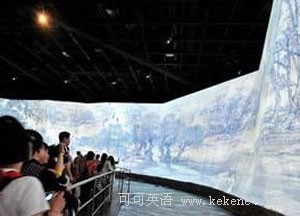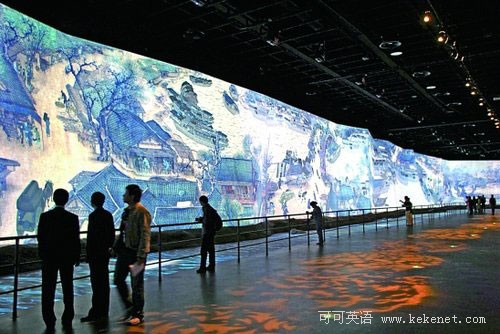(单词翻译:单击)

导语: “ 清明上河图”是一幅描绘北宋首都汴京的城市风光长卷,根据统计,画中总共有各色人物1659个,动物209只,比四大名著中任何一部所描画的人物都要多。
如果我们要像外国游客介绍中国馆的这个镇馆之宝,应该怎样描述呢?首先,“清明上河图”的名称翻译就有许多不同的说法,然而也大同小异,如:Riverside Scene During The Qingming FestivalThe Qingming Festival By The Riverside等,维基百科上的翻译则是:Along the River During the Qingming Festival。当然,对于这里的Qingming Festival,还是要做一点进一步的解释,说明一下清明节的性质,一般来说,清明节的通俗说法是tomb-sweeping day。
我们来看看清明上河图到底描绘了些什么样的景色吧:

It capturesthe daily life of people from the Song period at the capital, Bianjing, today's Kaifeng. The theme celebrates the festive spirit and worldly commotionat the Qingming Festival
这幅画描绘了宋朝首都汴京(即今天的开封)中人们的日常生活,主题侧重于渲染清明节的节日气氛和喧闹景象。

The entire piece was painted in hand scrollformat and the content reveals the lifestyle of all levels of the society from rich to poor as well as different economic activities in rural areas and the city.
整幅画是在一张长卷上绘制的,画面上主要描绘了社会各阶层人物的活动,以及乡村城市间不同的经济生活。

The painting is famous because of its geometricallyaccurate images of boats, bridges, shops, and scenery. Because of its fame, it has been called "China's Mona Lisa".
这幅画以其对船只、桥梁、商店和风景的精确描绘而成名,被称为中国的蒙娜丽莎。
从清明上河图中我们可以一窥北宋时期繁华的城市风貌,连片的茶楼,tea house;酒肆,bistro;饭馆,diner;以及汴河上的拱桥archbridge;成群结伴去进行spring outing踏青的人们;以及各色人物,有小商小贩,vendorsand peddlers;街头卖艺者,jugglers;贫民和乞丐,paupers;游方和尚,monks,占卜算命者,fortune tellers and seers;旅馆老板,innkeepers;工匠,metalworkers and carpenters等等,令人眼花缭乱,目不暇接。北宋时的城市规模和繁华程度在世界上是其他国家所难以比肩的,本届世博会以城市生活为主题,展出这样一幅表现古代城市风光的名画,自然再合适不过了。


